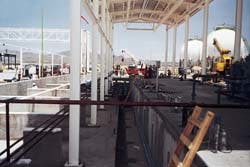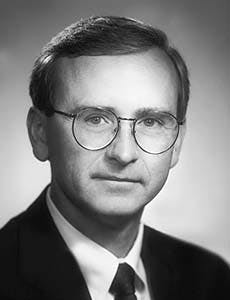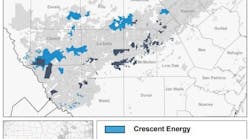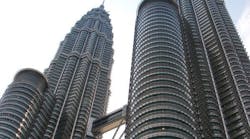Kevin C. Bodenhamer
Mid-America Pipeline Co.
Tulsa
Pump unit housing is under construction at Pemex-Gas y Petroquímica Básica's Méndez LPG terminal near Juárez with both 15,000-bbl storage units (background) nearly complete. (Photograph courtesy of Pemex-Gas y Petroquímica Básica, Mexico City)
- Méndez Terminal [37,494 bytes]
Supplying the terminal is the 265-mile, 8-in. Rio Grande Pipeline that includes a reconditioned 217-mile, 8-in. former refined-products pipeline from near Odessa, Tex., and a new 48-mile, 8-in. line beginning in Hudspeth County and crossing the U.S.-Mexico border near San Elizario, Tex. (Fig. 1) [33,992 bytes]. Capacity of the pipeline is 24,000 b/d.
Mid-America Pipeline Co., Tulsa, operates the U.S. portion of the pipeline. Pemex-Gas y Petroqu!mica B sica (PGPB) operates the Mexican portion as well as the Méndez terminal.
The Rio Grande Pipeline is the first to carry LPG across the U.S.-Mexico border. The U.S. portion of the pipeline is a Texas partnership, whose principal owners are Mid-America Pipeline Co., 45%; Amoco Pipeline Co., Oakbrook Terrace, Ill., 30%; and Navajo Pipeline Co., Artesia, N.M., 25% ,(Fig. 2) [12,585 bytes]..
The LPG supplied to Mexico is a blend of approximately 85% propane and 15% butane. Before construction and operation of the pipeline, PGPB blended the propane-butane mix at a truck dock during loading. (See the accompanying box on the Méndez LPG-receiving terminal.)
Demand for LPG in northern Mexico is strong. Less than 5% of the homes in Juárez have natural gas, making LPG the predominant energy source for cooking and heating in a city of more than a 1 million. LPG also is widely used as a motor fuel.
Path to Mexico
Product originates as propane and normal butane delivered into the underground storage system of Mid-America's Hobbs complex in Gaines County, Tex. The products are blended at Hobbs and transported 61 miles south on Mid-America's 8-in. Snyder Blue Line to the TXL pump station.After another 7 miles, product flows into Lawson Junction near Odessa in Ector County, starting point for the Rio Grande Pipeline.
LPG then moves 217 miles west on an 8-in. line previously owned by Navajo, passing through Delaware pump station to a point in Hudspeth County, Tex., where the grassroots part of the line begins.
The international custody-transfer station is 26.5 miles away, near San Elizario, Tex. (Fig. 3) [9,607 bytes]. It is then only a few thousand feet to the border where the line crosses the Rio Grande River and ownership of the system changes to PGPB.
From the border, LPG travels 21.5 miles west in the new 8-in. line to the Méndez terminal.
Project division
The Rio Grande Pipeline project was divided into six major subprojects:
- Completion of the Méndez terminal
- New pipeline in Mexico
- New pipeline in Texas
- One new pump station
- Rehabilitation and conversion of Navajo's refined products line
- Modifications to Mid-America's system at Hobbs and the TXL pump station.
The terminal also has a state-of-the-art programmable logic controller (PLC), vehicle tracking system, and operator control systems.
The new pipeline in Mexico consists of 21.5 miles of 85/8-in. pipe with a maximum operating pressure of 1,440 psig. The companion new line in Texas is 26.5 miles long with the same specifications.
The design rate required a grassroots pump station. Located in the Delaware Mountains of Culberson County in far West Texas, the station has an 800-hp electric motor that drives an 11-stage, horizontal, split-case Bingham pump.
Within the partnership, Navajo sold 217 miles of existing 85/8-in. pipeline to Rio Grande Pipeline. This section runs from the start of Rio Grande Pipeline to the new construction in Hudspeth County.
Rehabilitation of the line took place in two phases, dividing the work into eastern and western sections.
Navajo internally inspected the eastern section with a Line-A-Log tool from Tuboscope Vetco Pipeline Services, Houston, and made the necessary repairs before selling the line to Rio Grande Pipeline.
The western section was internally inspected by British Gas Inspection Services Inc., Houston, with repairs made by Rio Grande Pipeline which also performed the final hydrotest of the rehabilitated line.
Modifications to Mid-America's system involved the installation of a blending unit at Hobbs complex, replacement of a main line pump at TXL station, and reversal of check valves on the Snyder line.
In addition to these major components, Rio Grande Pipeline installed custody-transfer measurement at the Mid-America delivery point in Ector County and at the PGPB receipt location in El Paso County.
Contracts, permitting
The project kicked-off after the definitive agreements were signed by Rio Grande's partners and PGPB on Nov. 21, 1995. A project team was assembled and staffed by employees of Mid-America, Amoco, and independent contractors.
The project team quickly focused on completing the terminal within a 9-month target and obtaining a Presidential Permit required to begin construction on the grassroots line that crosses the border.
Penalty clauses in the contracts would be executed if the entire pipeline was not completed within 18 months.
Fluor Daniel Williams Bros., Tulsa, and ICA Fluor Daniel, Mexico City, were chosen to perform the engineering and design services for Méndez and the new line on both sides of the border. Radian Corp., Austin, was selected to perform the environmental assessment and obtain the Presidential Permit.
In addition, Dresser Engineering Co., Tulsa, was chosen to design and engineer Delaware Pump Station, Lawson Junction, and modifications to Hobbs and TXL. The remainder of the technical support came from the project team and internal Mid-America personnel.
The Presidential Permit required approval by the U.S. State Department, nearly 20 other U.S. federal agencies, and the Mexican government. Permits also were obtained from the U.S. Army Corps of Engineers, U.S. International Boundary and Water Commission, El Paso, Texas Railroad Commission, and the Texas State Historical Preservation Office.
Radian began this work in December 1995 and essentially completed it with the filing for the Presidential Permit application on May 10, 1996. The Presidential Permit was granted on Aug. 22, 1996.
Terminal
Design work on Méndez proved to be more challenging than obtaining regulatory approvals.Construction of PGPB's Méndez terminal had begun about 5 years earlier. It was originally designed to be supplied by rail and truck.
Work had started and stopped twice, leaving the terminal about 60% complete. After Fluor Daniel obtained all of the previous design drawings and data, it was discovered that three different engineering firms had modified the drawings.
Field reconnaissance confirmed that all construction was not shown on the drawings with the latest revision numbers.
The terminal was redesigned to both U.S. and Mexican standards, with the most stringent prevailing. ASME 31.3, National Electrical Code NFPA 70, and the Uniform Building Code were the primary codes.
Field construction at Méndez was divided into three primary contracts:
- Fluor Daniel/ICA, Mexico City, was given the architectural and civil work.
- A consortium of H.C. Price, Dallas, and ARB/Smiconsa, Bakersfield, Calif., performed the mechanical/
- electrical construction.
- G.S.E. Systems Inc., Columbia, Md., did the controls and programming.
Civil and architectural work started in May 1996, with mechanical and electrical beginning in June 1996.
As construction progressed, many on-site discoveries were made. Underground utilities were not installed as shown, almost none of the existing piping met code requirements, and much of the existing equipment was unusable.
The combination of delays in design and construction pushed the already aggressive completion schedule from August to October 1996. However, PGPB began using the terminal in September with a temporary rail unloading facility.
During the entire design and construction process, PGPB and several Mexican federal agencies made numerous inspections and had the final approval of all work. This held true for both the terminal and pipeline in Mexico.
Operation of the terminal is highly automated, often incorporating secondary backup systems.
The primary control of the terminal is all electronic with a TI/Simons 565 PLC and an identical fiberoptic-linked hot backup. Information from the PLC is fed up to a local area network (LAN) whose backbone is a pair of 200-mhz computers.
The LAN also takes care of a truck card reader system, product accounting and inventory, and communication of information to PGPB in Mexico City. The truck card readers are similar to automated turnpike toll systems in the U.S.
Once a transport enters the terminal, the loading queue, dock assignment, fill capacity, and product accounting are all keyed from this identification system.
Méndez also has a fully integrated safety system. The major components of the system include a 2,000 gpm pressure-demand firewater system with diesel backup, permanent firewater monitors, spray and deluge systems for the 15,000-bbl spheres, fusible link hydraulically actuated emergency shutdown system, and numerous hazardous gas monitors.
Pipeline
Construction of the new pipeline in both Mexico and the U.S. was performed by a joint venture of H.C. Price and ARB. Price focused on the pipeline construction, while ARB worked on numerous directional drills (Fig. 5) [10,686 bytes].
Pipeline crews started on both sides of the border in early November 1996; the U.S. spread finished in late December.
The Mexican spread, completed in January 1997, had several delays from material importation problems, a 2-week work stoppage during Christmas, and a 1-week delay while equipment was held at gunpoint by landowners demanding additional compensation for right-of-way.
R.O.W. in Mexico was acquired by PGPB, and Rio Grande Pipeline provided the survey and plats.
Pipe for the project was supplied by CSI, Fontana, Calif. The majority of the order was for 85/8-in. OD, 0.188-in. W.T., API-5L X-52 with 0.322-in. API-5L X-42 used at road crossings and in populated areas.
All pipe was FBE coated, with shrink sleeves used on the joints.
Construction of the Delaware Pump Station, Lawson Junction metering facility, Hobbs blending unit, and TXL pump-station upgrade began in September 1996 and was completed by Holloman Construction, Odessa, in December 1996.
The eastern section of the Navajo pipeline was already out of service when the project began, allowing Navajo to complete repairs before the line was sold to Rio Grande Pipeline in July 1996.
Rio Grande Pipeline made some additional replacements and lowerings and hydrostatically tested the section to a 1,440 maximum allowable operating pressure. In all, approximately 44,000 ft of pipe were replaced.
Western section repairs did not begin until November 1996 when Navajo transferred the section to Rio Grande Pipeline. Approximately 35,000 ft of pipe were replaced, along with a complete hydrotest of the section.
Work was completed in March 1997 and signaled the beginning of Rio Grande Pipeline's commissioning process.
Operations, safety
As operator, Mid-America controls and monitors the entire system through a satellite link to its operations control center in Tulsa. All stations, measurement facilities, and pipeline in the lower Rio Grande Valley are equipped with motor-operated valves, controlled locally and from Tulsa.
Additional safety precautions installed in the lower Rio Grande Valley include a minimum of 4 ft of pipeline cover, warning signs in both English and Spanish, and a dial-up video camera at the San Elizario measurement station.
Local fire departments also have been trained and equipped with hazardous gas monitors.
In addition to other previously mentioned safety systems at the Méndez terminal, operations control has the ability to monitor pressure, flow, valve status, and sphere levels at Méndez. To help non-Spanish speaking controllers communicate with PGPB, arrangements have been made for 24 hr-a-day, on-demand translators through AT&T.
SHORTENING THE LINES
Between LPG supply and market distribution was a primary objective for Pemex-Gas y Petroqu!mica B sica (PGPB) in building the terminal and pipeline to receive, store, and distribute imported LPG at the Méndez terminal near Juá rez, state of Chihuahua, adjacent El Paso, Tex.The terminal is part of a larger project PGPB undertook in alliance with three U.S. companies. It was completed at yearend 1996 and received its first LPG shortly after Apr. 1, 1997.
LPG has been imported into Chihuahua state through Juárez, says PGPB, because of the long distance between the consuming markets of the state and the supply points at terminals at Cadereyta, near Monterrey, in neighboring state of Nuevo Leon, and Topolobambo, on the Gulf of California, state of Sonora.
Construction of the terminal began in 1992. Compa?!a Bosnor completed 65% of the project, but its contract was canceled in 1993 when it failed to meet work deadlines, says PGPB.
The original scope of the Bosnor contract included construction of a temporary loading facility (see diagram of terminal layout) which began operations in 1993 and which by Oct. 1, 1996, had delivered an average of 7,000 b/d.
In 1995, PGPB negotiated a strategic alliance with the U.S. companies Mid-America Pipeline Co., Tulsa, Amoco Pipeline Co., Oakbrook Terrace, Ill., and Navajo Pipeline Co., Artesia, N.M., to complete the plant and enable it to receive LPG from the U.S. through an 8-in. OD pipeline.
Negotiations led to an agreement between Pemex unit PMI Trading Ltd. and Rio Grande Pipeline Co., the new, jointly owned company created by the U.S. firms, in order to finish the project. Through this agreement, PGPB will buy LPG from the U.S. companies for 20 years.
Justification
Completion of the terminal and construction of the pipeline from the U.S. to Juárez will bring important economic benefits, according to PGPB, allowing more companies to participate in the supply of LPG and creating greater diversity of sources.
This diversity will enable PGPB to obtain competitive prices for the imported product, ensuring at the same time the ability to absorb future demand increases.
Furthermore, transportation costs will be reduced and it may even be possible eventually to purchase product directly at the U.S. gas-processing plant and have access to storage and mixing installations in the U.S.
The U.S. companies financed the project; PGPB will repay the debt by means of a surcharge of the transportation tariff.
Construction goals
Bosnor's original contracted work envisioned reception of butane and propane by tanker trucks, storage in spheres, mixture to yield LPG, and sale of the product.
The project as completed today includes receipt of LPG by pipeline, two storage spheres, a pumping station, and loading racks. Existing tanker unloading facilities serve as backup when pipeline supply is interrupted by repairs.
The terminal is located in Colonia Agrícola Plazuela de Acuña, Fracción No. 7, in the municipality of Juárez.
A 5-km road leads to the plant beginning at a point 7.5 km outside of Juárez on the road to Nuevo Casas Grandes. The Chihuahua-Pacífico railroad, Juárez-Nuevo Casas Grandes section, runs north-to-south on the east side of the plant.
Rio Grande Pipeline Co. has converted and built a pipeline from Mid-America's Hobbs complex, Gaines County, Tex., to the border, and from El Paso to the Méndez Station (see accompanying article).
An 8-in. pipeline was built according to API-5L-X52 specifications and 7,632 cu m/d (24,000 b/d) capacity for LPG. The mixture is 80 vol % grade "P" propane and 20 vol % grade "D" butane; or a 90/10 mix of the same. LPG arrives at Méndez storage with enough pressure and temperature (approximately 15.4 kg/sq cm [220 psi], 30° C.) to be sent directly to the loading racks on its own energy.
A third option to supply LPG to the terminal consists of four tanker truck-unloading positions which will be operated in a similar manner to the existing ones in the temporary facility.
Both storage spheres operate independently: while one is receiving LPG, the other is sending product to the loading pumps.
Whenever the LPG pipeline supply exceeds the demands of the loading racks' area, the surplus will be redirected toward the spheres by means of a pressure-control valve.
In the event that no LPG supply arrives through the pipeline, the product will be pumped from the storage spheres to the loading racks.
Each 2,385-cu m (15,000-bbl) sphere has panel indicators for pressure, temperature, and content level, as well as pressure relief, draining, and venting accessories.
Pumps and tankers
When the LPG pipeline is not in use, or it becomes necessary to reduce LPG volumes inside the spheres, LPG in the spheres will be pumped to the tanker truck-loading racks.
There are six loading racks in the terminal in addition to the existing ones in the preliminary facility. Usually, the loading racks will be directly supplied from the LPG pipeline, thus saving costs associated with pumping or gas compression for tanker truck loading operations.
The loading racks in the preliminary facility may be used as unloading facilities in case of an interruption in the supply of LPG to the terminal.
Two compressors in the terminal will suction from the upper part of the spheres and send LPG toward the tanker-unloading facilities. Each compressor is equipped with suction filter and instruments for fluid control and automatic shutdown activated by high pressure.
The truck-loading facility that provided supply before the construction of the pipeline can still be used as an alternate supply for the terminal should the LPG line be out of commission.
Modular equipment packages supply the hydraulic fluid to activate the various hydraulic valves. Each module consists of an oil tank, two pumps, a nitrogen accumulator, and connecting tubing and instrumentation inside the package. It will relay contact to the emergency shutdown system.
Fire fighting; hazard detection
The plant has a 1,000-cu m water tank to supply the fire-fighting network for more than 1 hr.Water flows into the tank from a well located inside the plant, which has enough water pressure to maintain the tank's water level under any circumstances.
The fire-fighting network has two electric motor pumps and one internal combustion motor pump which is activated if one of the others malfunctions.
The electric motors of the fire fighting pumps will be connected to the emergency plant.
In such high risk areas as storage and unloading and loading racks, the plant has a system for detecting explosive mixtures and fire. These systems are automatically activated in case of fire or explosive mixtures.
There are various safety measures connected to the supervisory control system.
Air for the plant and instruments is supplied by means of reciprocal compressors with an 80 std. cu ft/min and a discharge pressure of 125 psig.
Water is supplied to the following areas: main offices, restrooms and locker rooms, control booths (weighing, access, and communications), first aid, military security, maintenance shop, waiting room and truck drivers' rest rooms, control rooms (safety and pumps), and pumping station.
An open-architecture supervisory control and data-acquisition system (scada) receives signals from the subsystems via programmable logic controllers which are then processed to execute the necessary controls. Integrated subsystems are receiving and measurement, storage, tanker truck dispatch, access control, fire fighting, and interface with the administrative system.
The Author
Kevin C. Bodenhamer is general manager of projects and services for Mid-America Pipeline Co., Tulsa, and served as project director for the Rio Grande Pipeline. He has 19 years' experience in the design, construction, operations, and maintenance of pipelines, gas processing, fractionation, and underground storage facilities. Bodenhamer holds a BS in civil engineering from the University of Missouri-Rolla and is a registered professional engineer in Alaska, Kansas, Oklahoma, and Texas.
Copyright 1997 Oil & Gas Journal. All Rights Reserved.




